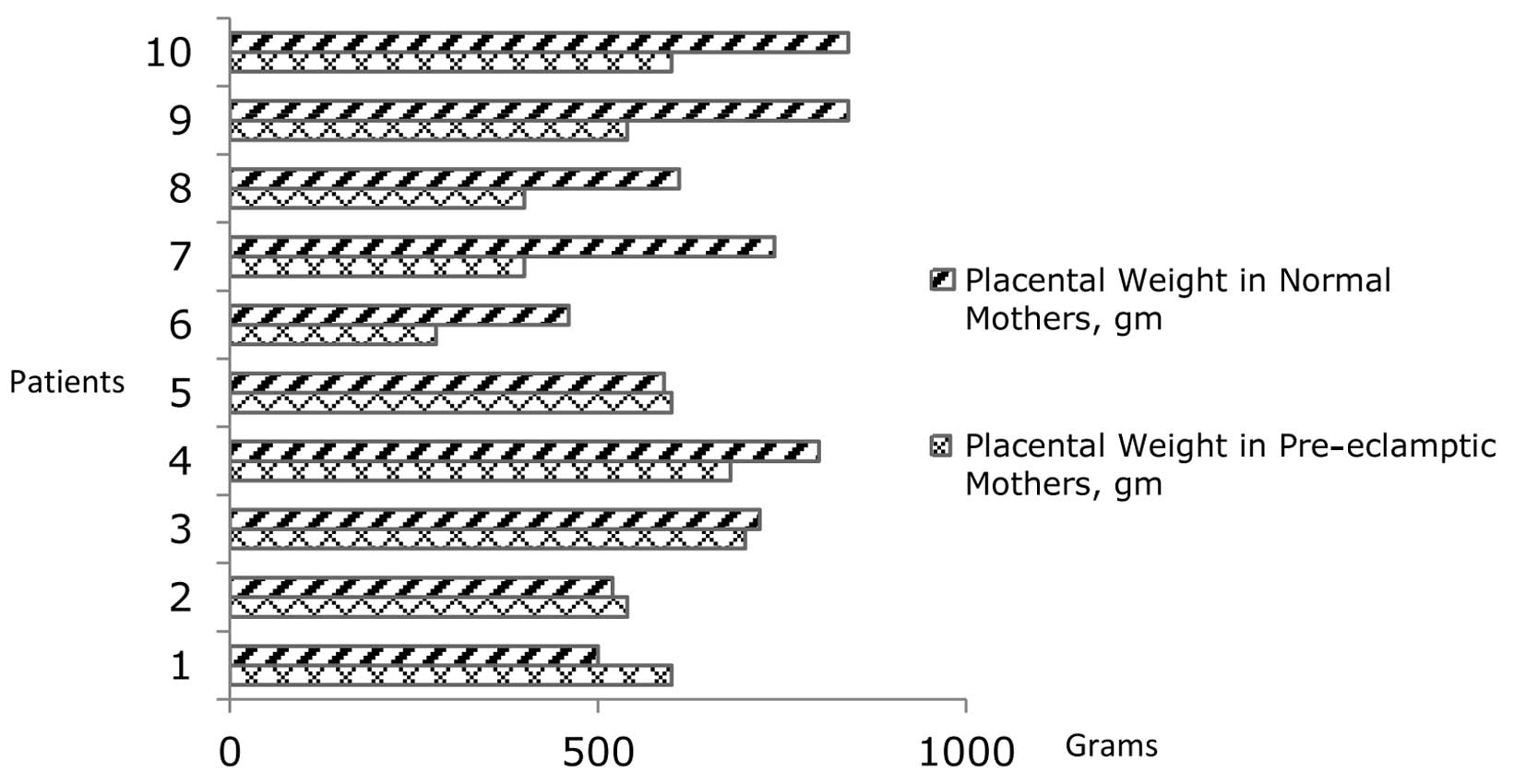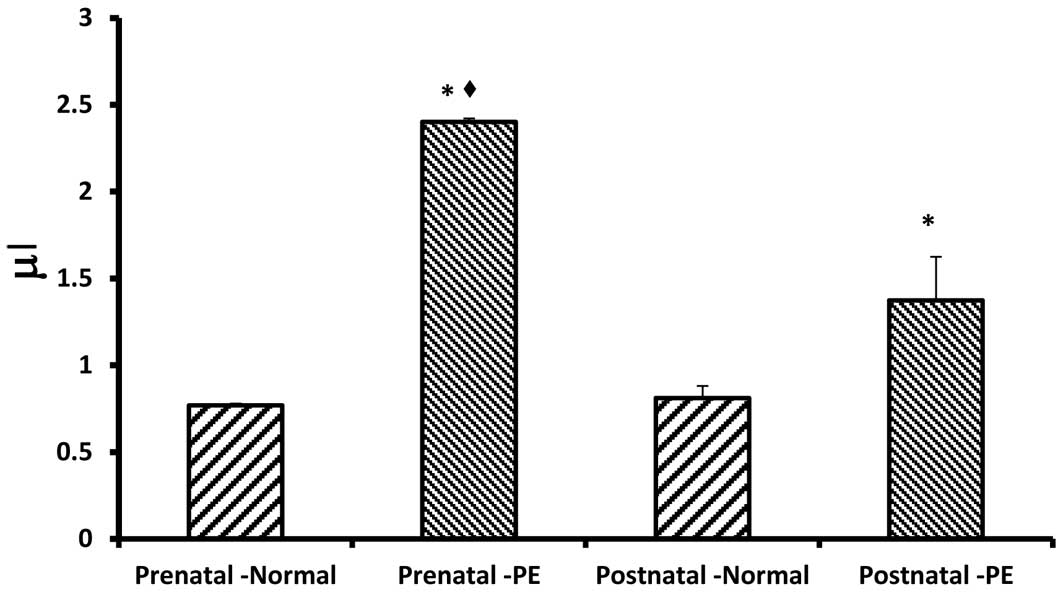Introduction
Pre-eclampsia is a pregnancy-specific disorder of
variable severity displaying a characteristic presentation with
well-defined diagnostic criteria in place solely based on physical
signs, such as hypertension and proteinuria, although some aspects
of its pathophysiology have yet to be ascertained and described.
The placenta being placed at a strategic location successfully
interfaces the maternal and foetal circulation during pregnancy and
exits its location immediately after delivery when it has fulfilled
its function. As a result of a physiological process termed
‘pseudovasculogenesis’, the spiral arterioles increase in diameter
and reduce in musculature thus increasing the amount of blood
supplied to the foetus, a process that is absent in
pre-eclampsia.
Pre-eclampsia has been a major cause of maternal and
foetal mortality worldwide despite its predictable presentation.
The need for a predictive marker for pre-eclampsia is understated
but has been a subject for discussion throughout the scientific
community. The search for a consistently expressed and easily
measurable ‘substance’ that can act as a marker for pre-eclampsia
is still underway and therefore defines the purpose of this
study.
Hypoxia-inducible factor-1α (HIF-1α) is a
transcription factor transiently expressed as a protein (1,2), also
binding to hypoxia-response elements (HREs) in the promoters of
several genes involved in the adaptation to an environment of
hypoxia. Its consistent presence in hypoxic milieus renders it a
notable candidate for pre-eclampsia-related research. Previous
studies have demonstrated the presence of HIF-1α in pre-eclamptic
placentas (1,2), but whether escalating levels of the
protein parallel aberrant pseudovasculogenesis has yet to be
evaluated. This study aimed to determine whether or not the
increased levels of HIF-1α can be used to demonstrate failed
placentation in pre-eclamptic mothers, thereby establishing its
credibility as a blood marker for pre-eclampsia.
Materials and methods
A case-control pilot study involving two groups of
ten mothers with and without pre-eclampsia, respectively, was
initiated by the authors from the International Medical University,
Kuala Lumpur, Malaysia, in collaboration with the co-authors from
Hospital Ampang, Kuala Lumpur, Malaysia. Consenting mothers (age,
<45 years), with newly diagnosed pre-eclampsia and devoid of
co-morbidities such as diabetes mellitus and essential
hypertension, formed the study group, while consenting mothers
within the same age group with normal pregnancies constituted the
control group. The study was approved by the ethics committee of
International Medical University, Kuala Lumpur, Malaysia. HIF-1α
transcription factor levels were measured in venous blood drawn
antenatally at diagnosis, and thereafter immediately after delivery
of the placenta by enzyme-linked immunosorbent assay (ELISA).
Additional characteristics such as placental weight and urinary
protein levels were included. Data are expressed as the means ±
standard error of the mean (SEM). Data were analyzed using analysis
of variance coupled with a post hoc Tukey’s test for multiple
pairwise comparisons. P<0.05 was considered to indicate a
statistically significant difference.
Results
The age of the pre-eclamptic mothers included in the
study ranged from 20 to 35 years, while that of the normal mothers
ranged from 23 to 35 years.
The placental weights in normal mothers were greater
when compared to the pre-eclamptic mothers (Fig. 1). Twenty-four-hour urine protein
levels in pre-eclampsia patients measured up to a maximum of 6 g.
Notably, the blood pressure measurement in the patient with maximal
proteinuria was the highest reading recorded at diagnosis.
Levels of HIF-1α transcription factor were observed
to reflect failed pseudovasculogenesis in mothers with
pre-eclampsia. The HIF-1α levels in prenatal blood samples of the
mothers with pre-eclampsia were higher compared to levels in
postnatal blood samples, achieving a 100% correlation. The
percentage reduction of mean HIF-1α levels postnatally in mothers
with pre-eclampsia was 42.81% (Fig.
2).
The values attained suggest that the levels of
HIF-1α transcription factor in the blood of mothers with
pre-eclampsia decreased following delivery of the placenta,
supporting the assumption that the placenta could be responsible
for this particular disease (1,4). In
normal mothers the HIF-1α levels were comparatively low in pre- as
well as postnatal blood samples, demonstrating similar mean values
(0.77 and 0.81, respectively).
Discussion
Placental weights of the pre-eclamptic mothers were
lower compared to placental weights of normal mothers. This may be
attributable to placental ischaemia due to aberrant
pseudovasculogenesis. This finding correlated with those of Pandit
et al (3) in their study on
placental weights in 100 cases of pre-eclamptic placentae (3).
The presence of HIF-1α in ischaemic environments and
its increased levels in the blood of mothers with pre-eclampsia are
compelling features to study this transcription factor as well as
its role as a predictor of pre-eclampsia.
The presence of HIF-1α transcription factors, albeit
in extremely low quantities, may present a debate regarding the
utility of this transcription factor as a predictor for
pre-eclampsia if measured in early pregnancy. However, it suggests
that should the levels of this transcription factor be measured
more frequently, a steady increase of HIF-1α levels could still be
commensurate with a potential development of pre-eclampsia at a
later trimester. Further research should be conducted as a
population-based study on a larger research cohort.
Abbreviations:
|
HIF
|
hypoxia-inducible factor
|
|
HRE
|
hypoxia-response elements
|
|
ELISA
|
enzyme-linked immunosorbent assay
|
References
|
1
|
James JL, Stone PR and Chamley LW: The
regulation of trophoblast differentiation by oxygen in the first
trimester of pregnancy. Hum Reprod Update. 12:137–144. 2005.
View Article : Google Scholar : PubMed/NCBI
|
|
2
|
Rajakumar A and Conrad KP: Expression,
ontogeny, and regulation of hypoxia-inducible transcription factors
in the human placenta. Biol Reprod. 63:559–569. 2000. View Article : Google Scholar : PubMed/NCBI
|
|
3
|
Pandit A, Kamlesh R and Niranjan M:
Foeto-placental weight relationship in normal pregnancy and
pre-eclampsia-eclampsia-A comparative study. Bombay Hosp J.
53:2011
|
|
4
|
Tan KH, Kwek K and Yeo GSH: Epidemiology
of pre-eclampsia and eclampsia at the KK women’s and children’s
hospital, Singapore. Sg Med J. 47:482006.PubMed/NCBI
|
















